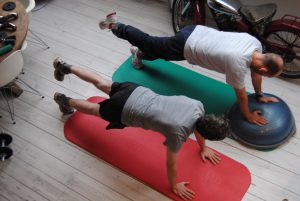Our practice stands for a professional rehabilitation geared to the patient and his problem. Complaints are treated with manual techniques, a guided exercise therapy, massage or physical therapy. Moreover, an exercising programme and tips are given for at home, for a faster recovery
In addition to general physiotherapy rehabilitation, in our practice we offer different specific treatments, such as:
- Sports rehabilitation and Medical taping
- Respiratory physiotherapy
- Manual therapy
- Corestability training
- Cardiovascular training
- General physiotherapy
Sports rehabilitation and Medical taping
Sport rehabilitation is used to let the body function again at the previous level after having incurred a sports injury. It may concern an acute trauma, but also a strain injury.
Individual appropriate treatment, guidance and testing of the sportsman makes sure that he can resume sports activities as soon and as safe as possible. Gradually building up the load is an important factor here.
 Medical taping can offer a functional support for the manual and remedial therapy within the sport rehabilitation by applying a classic tape or kinesiotape. As such we seek to get the patient moving again as quickly as possible, which also favours the intrinsic healing without the adverse consequences of a too long immobilisation.
Medical taping can offer a functional support for the manual and remedial therapy within the sport rehabilitation by applying a classic tape or kinesiotape. As such we seek to get the patient moving again as quickly as possible, which also favours the intrinsic healing without the adverse consequences of a too long immobilisation.
The use of elastic tape provides a comfortable feeling, a long lasting support, even after showering, and the natural movements are not prevented, just supported.
Respiratory physiotherapy
The aim of respiratory physiotherapy is to clear the mucus (slime) from the lungs of the patient as fast as possible and to enable quiet breathing. To pursue a normal breathing pattern and to teach the patient to control his breath is also one of the goals.
Acute, chronic, post-operative lung disorders, such as bronchitis, pneumonia, COPD (Chronic Obstructive Pulmonary Disease), ABPA (Allergic Bronchopulmomary Aspergillosis), mucoviscidosis, bronchiectasis, asthma, hyperventilation … are treated by means of specific breathing techniques:
- Autogenic drainage
- Thoracic and vertebral mobilisations
- Guidance/supervision on using aerosol therapy, puffer or dry powder inhaler
- Effort exercises and/or relaxation.
Manual therapy
Manual therapy is used for persons with problems of the locomotor system (the spinal column and the joints of the arms and legs). Overloading the joint is often the cause of the complaint. Moving then becomes difficult and painful. Muscles may also cramp and the pain may radiate to other parts of the body.
The manual therapist remedies the functional disturbance by applying specific passive mobilising movements. By moving the parts of the body in a certain way around the joint, it is possible to quickly increase the mobility of the joints. The pain lessens and the movement of the joints can be improved.
Corestability training
 Corestability training or trunk stabilization training can not be ignored at various sport training courses. The goal of this stabilization training is to strengthen the trunk muscles (mainly the abdominal and back muscles). In stabilization training, attention is paid to the posture, learning to address a good postural control and a muscle tone for a better body awareness.
Corestability training or trunk stabilization training can not be ignored at various sport training courses. The goal of this stabilization training is to strengthen the trunk muscles (mainly the abdominal and back muscles). In stabilization training, attention is paid to the posture, learning to address a good postural control and a muscle tone for a better body awareness.
Good body awareness is necessary during daily life, but certainly also during sports.
Sitting in a chair or at a desk for a long time and standing tall are not to be underestimated for the joints. Especially when the muscle corset is not working properly.
Strengthening the trunk muscles provides an increase in performance and reduces the risk of injuries.
Cardiovascular training
It is impossible to imagine certain sport trainings without core stability training or torso stabilisation training. The aim of this stabilisation training is the reinforcement of the core muscles (especially the abdominal and dorsal muscles). During the stabilisation training emphasis is put on the posture, on learning to apply a good postural control and on muscle tension for a better body awareness.
A good body awareness is necessary during daily life, but certainly so when practising sports.
Sitting on a couch or at a desk for a long time and standing up for long periods are loads on the joints not to be underestimated. Even more so when the muscle corset doesn’t function well.
Reinforcing the core muscles ensures an increased performance and reduces the risk of injury.
Cardiovascular training concerns the pre- and post-operative rehabilitation of the heart, blood vessels and lungs. By means of an individual training programme, on the one hand attention is paid to breathing and on the other hand the optimisation of the physical condition is pursued.
The exercises and efforts improve the heart function and increase the effort capacity. This leads to a better physical condition and a higher endurance.
General physiotherapy
Most of the treatments for physiotherapy concern disorders of the locomotor system. This varies from tendonitis, rehabilitation after fractures, sprains or operations, to tension pains in the neck and shoulders, dorsal pains, stiff muscles and joints. Mobilisations, massage, active or passive remedial therapy, manual lymph drainage, electrotherapy, warm packing, ice,…

